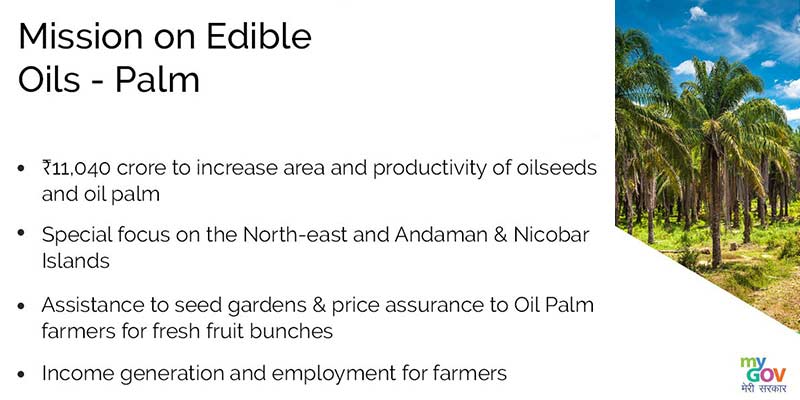- India
- Aug 19
Explainer / National Mission on Edible Oils-Oil Palm
The Union Cabinet approved the National Mission on Edible Oils-Oil Palm (NMEO-OP) with a financial outlay of Rs 11,040 crore to promote domestic cultivation of oil palm in the next five years, and reduce the country’s dependence on edible oil imports.
The decision comes after PM Narendra Modi announced the new central scheme during his Independence Day speech at Red Fort.
The proposed scheme will subsume the current National Food Security Mission-Oil Palm programme.
What is the significance of this scheme?
• India meets about two-thirds of its edible oil demand through imports.
• Since 1991-92, many efforts have been made by the Centre to increase the production of oilseeds and oil palm. The oilseeds production has increased from 275 lakh tonnes in 2014-15 to 365.65 lakh tonnes in 2020-21.
• For harnessing the potential of palm oil production, an assessment has been made by the Indian Institute of Oil Palm Research (IIOPR) in 2020 for cultivation of oil palm.
• The study revealed that oil palm can be cultivated in 28 lakh hectares in the country, out of which more than 9 lakh hectare in the northeast region.
• At present, only 3.70 lakh hectares is under oil palm.
• Thus, there is huge potential in oil palm plantation and subsequently production of Crude Palm Oil (CPO).
• Oil palm cultivation takes at least 5-7 years to give yield and profits. It was not possible for small farmers to wait for this long. Even if farmers were successful in cultivation, they were unsure of getting returns due to fluctuation in prices.
• The new scheme aims to cover oil palm in an additional area of 6.5 lakh hectares by 2025-26 and thereby reach the target of 10 lakh hectares.
• With this, the domestic production of crude palm oil (CPO) is expected to go up to 11.20 lakh tonnes by 2025-26 and up to 28 lakh tonnes by 2029-30.
• Oil palm produces 10 to 46 times more oil per hectare compared to other oilseed crops and has a yield of around 4 tonnes oil per hectare. Thus, it has enormous potential for cultivation.
• The new scheme is expected to benefit oil palm farmers, increase capital investment and generate employment. It may reduce the import dependence and also increase the income of the farmers.
How will the scheme be implemented?
• The financial outlay for the scheme is Rs 11,040 crore.
• Of the total outlay, Rs 8,844 crore would be the central government’s share while Rs 2,196 crore would be states’ share. This includes the viability gap funding.
• There are two major focus areas of the scheme.
• The oil palm farmers produce Fresh Fruit Bunches (FFBs) from which oil is extracted by the industry. Presently, the prices of these FFBs are linked to the international CPO prices fluctuations.
• The government will give a price assurance to the oil palm farmers for the FFBs. This will be known as the viability price.
• This will protect the farmers from the fluctuations of the international CPO prices.
• This viability price shall be the annual average CPO price of the last five years adjusted with the wholesale price index to be multiplied by 14.3 per cent.
• This will be fixed yearly for the oil palm year from November 1 to October 31.
• This assurance will inculcate confidence in the Indian oil palm farmers to go for increased area and thereby more production of palm oil.
• A formula price will also be fixed which will be 14.3 per cent of CPO and will be fixed on a monthly basis. The viability gap funding will be the viability price-formula price and if the need arises, it would be paid directly to the farmers accounts in the form of direct benefit transfer.
• Further, the assurance to farmers will be in the form of the viability gap funding and the industry will be mandated to pay 14.3 per cent of the CPO price which will eventually go up to 15.3 per cent. There is a sunset clause for the scheme which is November 1, 2037.
• To give impetus to the northeast and Andaman, the government said it will additionally bear a cost of 2 per cent of the CPO price to ensure that farmers are paid at par with the rest of India.
• The states which adopt the mechanism would benefit from the viability gap payment proposed in the scheme and for this they will enter into memorandum of understanding (MoUs) with the central government.
• The second major focus of the scheme is to substantially increase the assistance of inputs.
• The assistance to oil palm growers for planting material has been increased from Rs 12,000 per hectare to Rs 29,000 per hectare.
• Further, substantial increase has been made for maintenance and inter-cropping interventions.
• A special assistance at Rs 250 per plant is being given to replant old gardens for rejuvenation of old gardens.
• To address the issue of shortage of planting material in the country, seed gardens will be provided assistance up to Rs 80 lakh for 15 hectare in the rest of India and Rs 100 lakh for 15 hectares in northeast and Andaman regions.
• An assistance of Rs 40-50 lakh is given for seed gardens. Special assistance will be given to the northeast and the Andaman regions for half moon terrace cultivation, bio fencing and land clearance along with integrated farming.
• For capital assistance to the industry for the northeast states and Andaman, the scheme provides Rs 5 crore for setting up of a unit with 5 tonne per hour with pro-rata increase for higher capacity. This will attract the industry to these regions.
Manorama Yearbook app is now available on Google Play Store and iOS App Store

